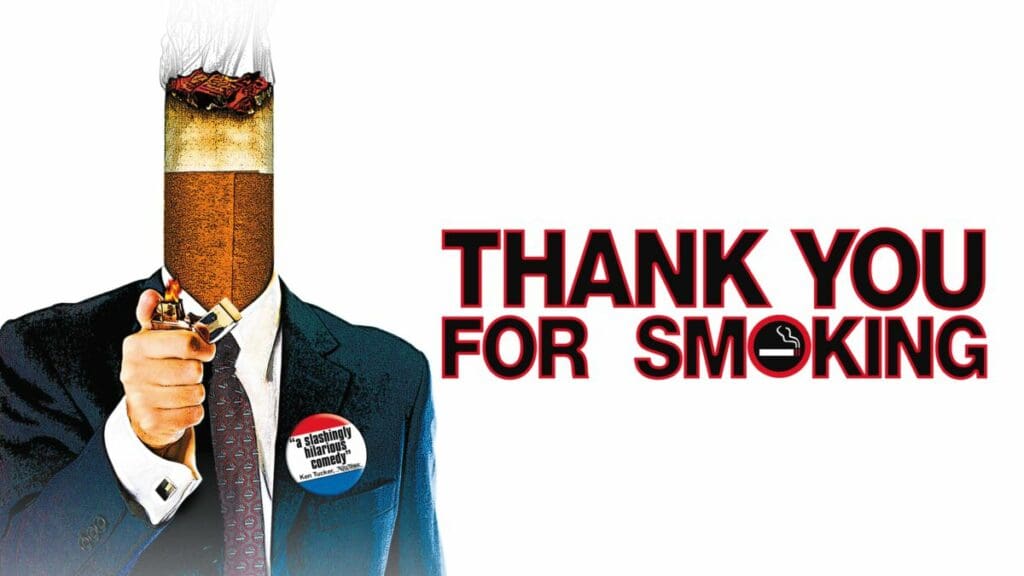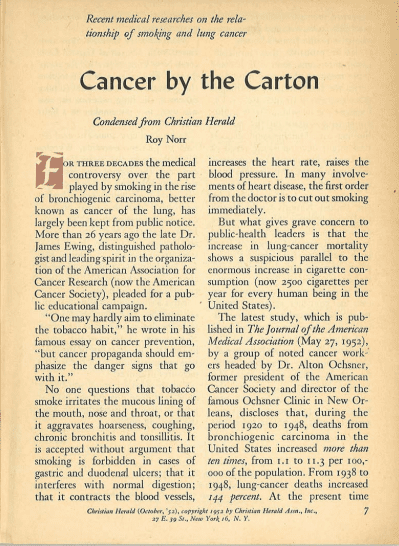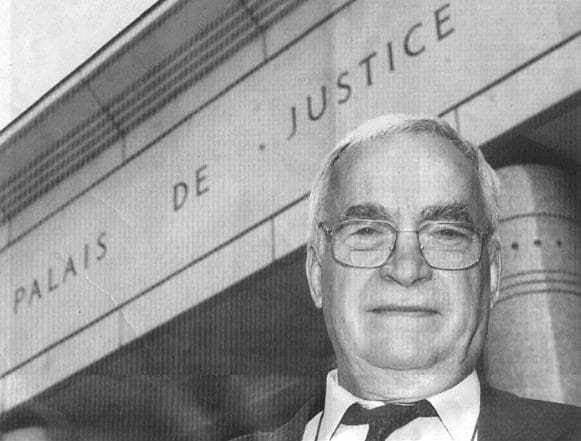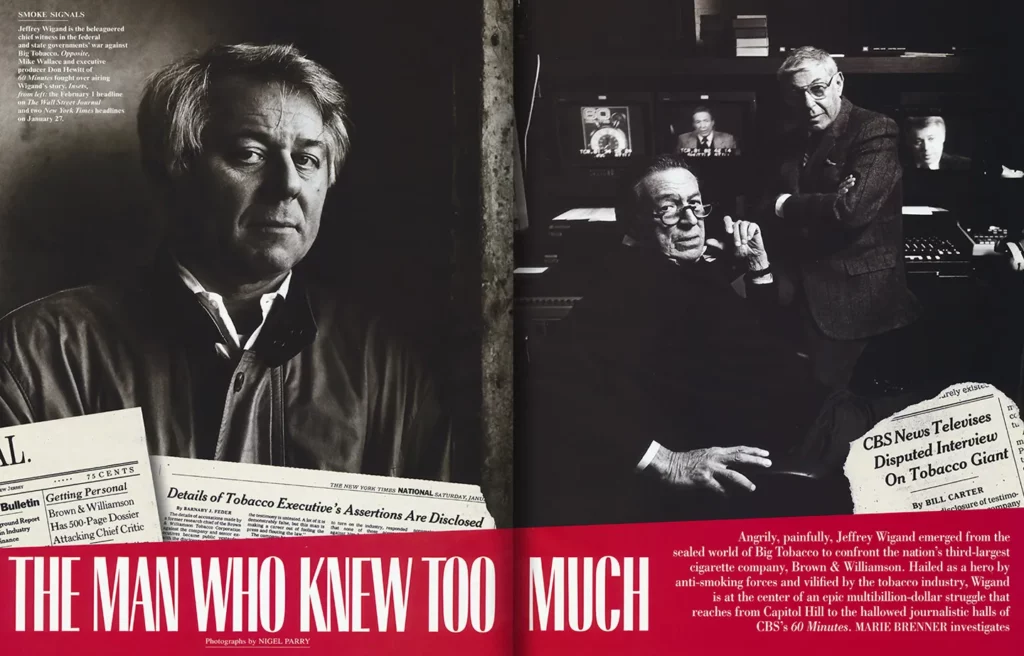“According to reported nationwide surveys, more doctors smoke CAMELS than any other cigarette.” “No throat irritation, no cough. Lucky Strikes, it’s toasted.” “Marlboro, the man-sized taste of honest tobacco.”
As we saw in part 4 of The Business of EMF Science, heavy marketing through ads like these is how tobacco companies created doubt to blindfold the public from published science on the subject.
But the advertisements are just a small part of what they did to stay in business.
This post will dive deep into the other ways the tobacco industry created doubt among the public so they would listen to them and not the scientists.
So, let’s begin.
Doubt is Our Product
If you’ve watched the film or read the novel Thank You for Smoking, you may be familiar with one particular scene where Nick Naylor (the lead) advises the executives to repeat the following mantra to the media and the public:

Want to Slash Your EMF Health Risks?
Want to Slash Your EMF Health Risks?
Good! Learn the one small change you should make right now.
“Although we are constantly exploring the subject, currently, there is no direct evidence that links cell phone usage to brain cancer.”
Sources say that the Nick Naylor character is derived from Richard Berman, a lawyer, PR executive, and a former very successful lobbyist for the tobacco industry.
The wireless industry still uses this mantra, which isn’t their own. They stole from were inspired by the remarkably successful tobacco industry.
They adopted this strategy of manufacturing doubt about their product’s potential adverse health effects. And sadly, it has worked for decades.
The tobacco industry used it to fend off regulation and negative public perceptions about their products. As one executive from Brown & Williamson (B&W), a tobacco giant, infamously wrote in a 1969 memo that eventually leaked to the public:
“Doubt is our product since it is the best means of competing with the ‘body of fact’ [linking smoking to disease] that exists in the mind of the general public. It is also the means of establishing a controversy.”
And the wireless industry is using it now for the same purpose.
How the Tobacco Industry Created Doubt
As you already saw in part 4 of The Business of EMF Science, tobacco companies used deceptive and blatantly false claims to reassure the public that their products were safe for consumption. For years, people only saw the value of smoking.
But after a while, serious concerns began to emerge about the dangers of smoking, as it takes quite a while for detrimental health effects to emerge.
This called for stricter regulations, which was terrible news for the tobacco industry. So, as any for-profit industry would do in this situation, they changed their marketing efforts. Let’s have a look.
Hiring Scientists to Not Deny But…
A vital part of the tobacco industry’s efforts involved bringing real-life scientists into the equation. They conducted seemingly sophisticated studies to determine whether smoking was really dangerous.
After performing several experiments, the scientists said that they couldn’t make a clear determination. Former government regulator David Michaels’ 2008 book “Doubt is Their Product,” summarizes everything that went into these experiments.
In his book, Michaels points out how the industry sought to create doubt about the health charge without actually denying it. This highly effective strategy aimed to fend off any regulatory action or corporate responsibility for the fatal impact of their actions.
Although they hired scientists, performed experiments, and spent millions researching tobacco, their main goal wasn’t to discover the facts. It was to create enough doubt so as to undermine any challengers’ claims and block any action from the authorities.
“No industry has employed the strategy of promoting doubt and uncertainty more effectively, for a longer period, and with more serious consequences,” writes Michaels.
Evidence At the Time
Even though the tobacco industry was performing its own studies, legitimate science on the subject also started to pile up.
In 1950, American scientists Ernst L. Wynder and Evarts A. Graham found that 96.5 percent of lung cancer patients were moderate to heavy smokers.
Wynder later followed up with another landmark study showing that painting cigarette tar on rodents’ bodies created tumors in most subjects.
But the ads didn’t stop.
It was only in 1952, when Reader’s Digest published a piece called “Cancer by Carton,” which highlighted the dangers of smoking, that cigarette sales fell for the first time in more than twenty years.
The Sound Science Campaign
This shook the tobacco industry. For the first time, their tactics weren’t working – people were believing in real science.
This was when they decided to fight science with science. So, in 1954, they created a Tobacco Industry Research Committee (TIRC), which launched the “Sound Science” campaign.
The sound science campaign was a multi-faceted, multi-national strategy to show that the dangers of tobacco, as scientists say, aren’t true.
They ran a full-page promotion in more than 400 newspapers, which reached around 43 million Americans. The promotion, entitled “A Frank Statement to Cigarette Smokers,” opens with these paragraphs:
“Recent reports on experiments with mice have given wide publicity to a theory that cigarette smoking is in some way linked with lung cancer in human beings.
Although conducted by doctors of professional standing, these experiments are not regarded as conclusive in the fieldIn the context of electromagnetic fields (EMF), the term "field" refers to a region in space where electric and magnetic forces are exerted. An electromagnetic field is generated by electrically... of cancer research. However, we do not believe that any serious medical research, even though its results are inconclusive, should be disregarded or lightly dismissed.
At the same time, we feel it is in the public interest to call attention to the fact that eminent doctors and research scientists have publicly questioned the claimed significance of these experiments.”
Dr. Ragnar Rylander
The sound science campaign, tobacco vs. science, all of these started in the ’50s. So, you’d think that after several decades, these campaigns and fights would eventually die down. But no.
This story is from 2002 when we had ample evidence that cigarette smoking is carcinogenic and can cause several kinds of cancer. Dr. Ragnar Rylander was a professor of environmental health at Gothenburg University in Sweden.
He published multiple papers denying the negative impacts of tobacco and second-hand smoke. One thing he failed to reveal in any of his papers is that he was receiving a boatload of money in grants and consulting fees from Philip Morris, a tobacco giant, for over 30 years.
He actively denied these accusations when people found out until someone uncovered his contract from the Philip Morris archives.
The matter went to a Swiss Court in Geneva. They said that Rylander failed to fulfill his “moral obligation” to disclose these financial ties. They declared that Geneva had indeed been the center of unprecedented scientific fraud. Rylander took advantage of his influence and reputation, not hesitating to put science at the service of money and not heeding the mission entrusted to this public institution.
The Whistle Blower
Coming back to the “Sound Science” campaign, the tobacco industry’s efforts to fight science with science was going with a breeze until they faced a final hurdle, which they couldn’t really jump.
This was when one of their own, Jeffrey Wigand, a B&W tobacco executive, put himself on the line as a whistleblower.
After years of deception, he found himself morally compelled to speak out. This happened when eight prominent tobacco executives testified under oath that nicotine wasn’t addictive at the 1994 U.S. Congressional hearing. And Wigand said this is it.
Just like all the other executives, Wigand knew the truth. So, he went on to reveal that Big Tobacco was consciously deceiving the public. This led to a multi-billion-dollar settlement in 1997, forcing the tobacco companies to pay $368 billion in healthcare costs due to smoking-related illnesses.
And the reason the tobacco industry couldn’t simply refute Wigand’s testimony was that millions of internal documents came into light supporting his testimony.
It Took Time
This was, we could say, the downfall of the tobacco industry. Though people like Dr. Rylander continued saying that tobacco isn’t harmful, the public knew better by then.
But it took a long time. Approximately 80 years. We now have data linking smoking to lung cancer, people clearly understand the dangers of smoking, and governments worldwide tightly regulate smoking. Some have even banned it.
This needed to happen in the ’50s or ’60s. It took way longer than it should have taken. But, hey, that’s how science works.
Until there’s no shred of doubt remaining, scientists continue to say we don’t know and search for answers.
But this translates to decades of people using what’s harming them and billions of dollars created from their involuntary sacrifices.
Tobacco’s fame died down. But the strategies the industry used are still very much alive. And this time, it’s the wireless industry using them.
The Wireless Industry & The Tobacco Playbook: The Interphone Study (Preview)
When what they had to say was simply, “our cell phones are safe,” they chose to say, “currently, there is no direct evidence that links cell phone usage to brain cancer.”
And although these two sentences look similar, they mean two completely different things. One is saying that you have absolutely nothing to worry about, and another is saying we think you have absolutely nothing to worry about until science says otherwise.
So, what does this do? Create doubt among the public. And as long as there’s doubt, the wireless industry can continue to thrive.
In the case of smoking, though we finally agreed on the fact that smoking is hazardous, by then, millions of people had died. So, what happens if science unites 50 years later that human-made EMF radiation"Radiation" in the context of Electromagnetic Fields (EMF) refers to the process by which energy is emitted and transmitted through space or a material medium in the form of electromagnetic... is harmful to our health? The same thing. Millions will have suffered the consequences of EMF exposure.
And this time, it’s even more dangerous. Why? Because we can quit smoking without it adversely affecting us. We don’t need it to regulate our daily lives. But EMF is different. It’s become part of the very fabric of our existence.
So, if we all agree that EMF is dangerous 50 years from now, we most likely will have to live with the problems.
But until then, the wireless industry will continue to fuel our doubts. And that’s what my next post in this series is about. So, stay tuned.
If you haven’t read my previous posts in this series, hit the button below to access all of the posts.
Final Thoughts
The aim of The Business of EMF Science series isn’t to make you hate modern tech or give up your beloved gadgets. We simply want you to be aware of what’s going on behind the curtain so you can take precautions and be on the safer side while still enjoying the convenience of modern technology.
And here at Shield Your Body, we have tons of resources to teach you how to do that. I recommend you begin with the SYB Healthy Living Tips page.













